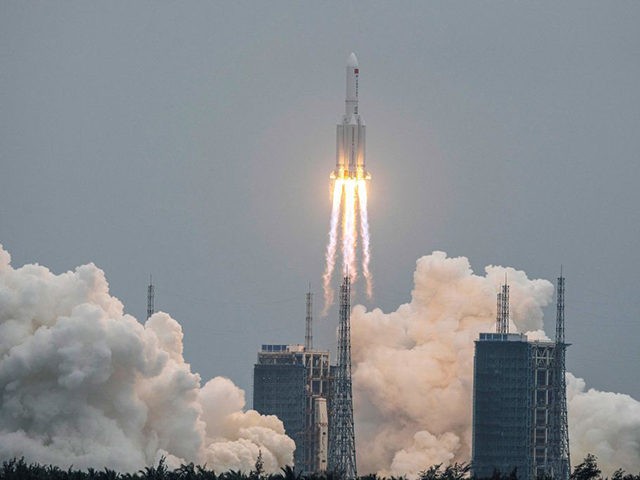China used an immense Long March-5B rocket last week to boost the living quarters module of its planned space station into orbit. The 21-ton body of the rocket is now whipping around the Earth in an uncontrolled orbit and could fall to Earth within the next few days, potentially raining debris on an inhabited area.
Space News reported soon after last Wednesday’s launch that the Tianhe space station module appears to have achieved orbit as planned, but the core stage of the Long March-5B rocket also made orbit — unlike most expendable launch vehicles, which are designed to fall back to Earth and land in a pre-arranged re-entry zone.
“There had been speculation that the Long March 5B core would perform an active maneuver to deorbit itself, but that appears not to have happened,” Space News reported, noting Chinese officials are characteristically secretive and evasive about what was supposed to happen to the rocket.
What actually did happen, according to amateur ground observers who do not answer to the Chinese government, is that the huge rocket body appears to be tumbling out of control at high speed, circling the world once every 90 minutes, and is “likely to make an uncontrolled reentry over the next days or week as growing interaction with the atmosphere drags it to Earth.”
“If so, it will be one of the largest instances of uncontrolled reentry of a spacecraft and could potentially land on an inhabited area,” Space News warned.
At this time, the precise location of re-entry is “impossible to predict” because the rocket body is beginning to interact with Earth’s atmosphere, but the cone of possibility includes cities like New York, Madrid, and Beijing. The risk of property damage or human casualties is likewise impossible to calculate, but hopefully the debris will either burn up in the atmosphere or fall into the ocean, without menacing any aircraft on its way down. Spaceflight experts said the landing area probably cannot be determined until about six hours before impact.
Spaceflight experts noted that responsible powers have not allowed any single object over ten tons to make uncontrolled reentry since 1990. China has not acted as a responsible power during its mad dash to catch up with the U.S. space program after putting its first man in orbit in 2003. China’s previous use of a Long March-5B rocket for orbital insertion in May 2020 left a 20-ton core stage tumbling out of control over Africa.
Some of the debris survived re-entry and came down near the Ivory Coast, including an intact pipe about 12 feet long found by villagers who heard loud noises and flashes of light from the reentry. Some damage to buildings in the region may have been caused by fragments of the Chinese rocket, although it was difficult to conclusively determine the cause of all structural damage local residents reported.
“It was seemingly a successful launch, until we started getting information about a reentry of a rocket body, a reentry that was really dangerous. It flew over population centers and it reentered Earth’s atmosphere. It could have been extremely dangerous. We’re really fortunate in the sense that it doesn’t appear to have hurt anybody,” NASA Administrator Jim Bridenstine said after the debris came down.
NASA has been trying to get other countries to sign a package of agreements called the Artemis Accords that would, among other things, enforce debris mitigation guidelines. Bridenstine criticized both China and India last year for launches that would not have been compliant with the Artemis Accords. International observers vainly hoped China would learn from the previous launch and design future Long March rockets to come back to Earth instead of entering orbit, but this does not appear to be the case, or else the de-orbiting system on the current rocket failed.
“It’s potentially not good. Last time they launched a Long March 5B rocket they ended up with big long rods of metal flying through the sky and damaging several buildings in the Ivory Coast. Most of it burned up, but there were these enormous pieces of metal that hit the ground. We are very lucky no one was hurt,” Harvard astrophysicist Jonathan McDowell told the UK Guardian on Monday, recalling the May 2020 incident.
McDowell noted the odds are good that most debris will fall into the sea, since water covers most of the Earth’s surface, but said ground impacts could be equivalent to “a small plane crash scattered over 100 miles.”
“What’s bad is that it’s really negligent on China’s part. Things more than ten tonnes we don’t let them fall out of the sky uncontrolled deliberately,” he said.
“China has been closely monitoring the movement of the debris,” an unnamed source within the Chinese space program told the South China Morning Post (SCMP) on Tuesday.
“The possibility of being hit by this debris is far lower than being involved in a car accident,” the Chinese source added.
China’s goal is to construct the Tiangong-3 space station, a 66-ton multi-module station that would remain operational for at least ten years. Tiangong-1 and 2 were test structures that were only used for short periods of time.
The 55-foot-long Tianhe module orbited last week is the core component of the new space station. The Chinese are planning at least ten similar launches over the coming year to boost the rest of the station into orbit.
If all goes according to plan, the International Space Station (ISS) — from which China was excluded — will leave service in 2024, leaving Tiangong-3 the only operational space station for some years afterward.

COMMENTS
Please let us know if you're having issues with commenting.